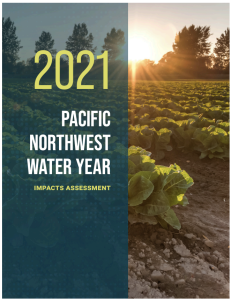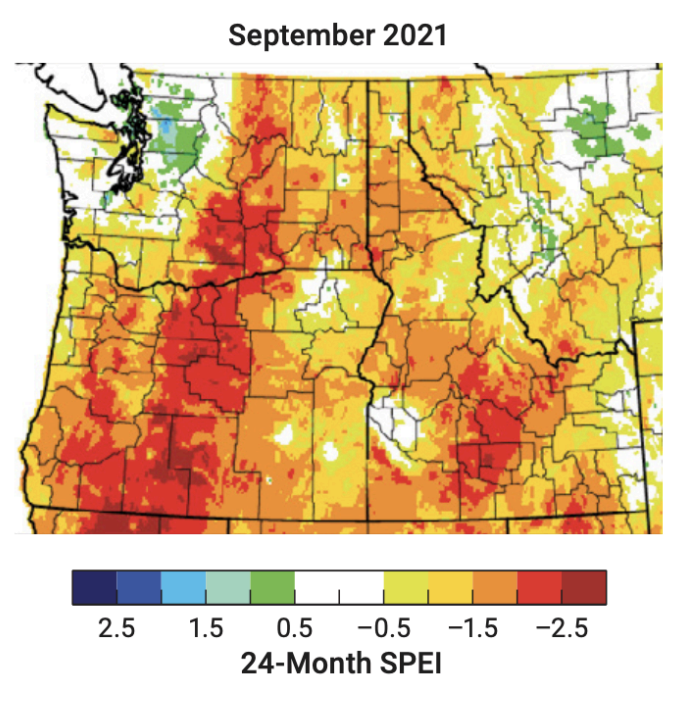PNW 2021 Water Year Impacts Assessment Released
 The second annual Pacific Northwest (PNW) 2021 Water Year Impacts Assessment was released a few weeks ago. This was a regional collaboration involving researchers and state and federal practitioners, sponsored by the NOAA National Integrated Drought Information System (NIDIS), and led by OWSC. The report focuses on the regional drought, recapping the weather and climate of water year 2021 (October 1, 2020- September 30, 2021), as well as sector-specific impacts and response actions. We encourage our readers to check it out at the following link: 2021 Pacific Northwest Water Year Impacts Assessment . In the present piece, we highlight three of the seven of the “Lessons Learned” featured in the report, which can be found on pages 6 and 7.
The second annual Pacific Northwest (PNW) 2021 Water Year Impacts Assessment was released a few weeks ago. This was a regional collaboration involving researchers and state and federal practitioners, sponsored by the NOAA National Integrated Drought Information System (NIDIS), and led by OWSC. The report focuses on the regional drought, recapping the weather and climate of water year 2021 (October 1, 2020- September 30, 2021), as well as sector-specific impacts and response actions. We encourage our readers to check it out at the following link: 2021 Pacific Northwest Water Year Impacts Assessment . In the present piece, we highlight three of the seven of the “Lessons Learned” featured in the report, which can be found on pages 6 and 7.
“Rapid changes in the spring of 2021 demonstrated the importance of considering a broader set of potential conditions when planning for drought.” As many of our readers are aware, spring of 2021 was remarkably dry throughout the PNW – ranking as the 2nd driest March-May since records began in 1895. The exceptionally dry spring, followed by a record warm summer, accelerated drought development and its impacts. Particularly for Washington, where most locations saw near- normal to above normal snowpack by April 1, 2021, the extent to which the dry spring ushered in drought conditions was mostly unforeseen. Overall, the extent to which dry (and not just warm) springs can lead to drought conditions and impacts may have previously been underappreciated.
“Multiple-year impacts of drought are possible and warrant planning.” For large areas of eastern Oregon and southern Idaho, persistent dry conditions and below normal snowpack during water years 2020 and 2021 have led to multi-year drought conditions. Even in WA, where precipitation in the fall and winter is typically sufficient for drought recovery, there are some locations in eastern WA where there have been substantial precipitation deficits spanning multiple water years. Figure 1 shows the 24-month Standardized Precipitation Evapotranspiration Index, a measure of drought that takes temperature and precipitation into account, ending in September 2021. From this perspective, the severity of the drought in the Lower Columbia basin of Washington state was on par with that seen in Oregon and Idaho. Long-term plans should account for these kinds of episodes.

“Compounded impacts of climate change and variability are becoming more diverse and affecting natural resources, agriculture, and water supply.” Across the PNW, the 2020 water year saw extensive impacts associated with drought and wildfire. In 2021, extensive impacts were associated with the heat wave in combination with drought. Their interplay certainly had consequences for natural resource managers, agricultural producers, and water providers. The specific contributions of various weather and climate factors are often difficult to tease apart, but better documentation and understanding of attributions should aid planning and ultimately mitigating the hardships associated with future adverse events.
We hope that this is enough of a teaser to entice your perusal of the report. One goal of the assessment is to provide ongoing documentation of the specific conditions that cause impacts, towards improving management of drought and other climate-related impacts in the future. We are open to your feedback on this effort!
Reference
Bumbaco, K.A., M.H. Rogers, L.W. O’Neill, D.J. Hoekema, C.L. Raymond. 2022. 2021 P acific N orthwest W ater Y ear Impacts Assessment . A collaboration between the Office of the Washington State Climatologist, Climate Impacts Group, Oregon State Climatologist, Idaho Department of Water Resources, and NOAA National Integrated Drought Information System.